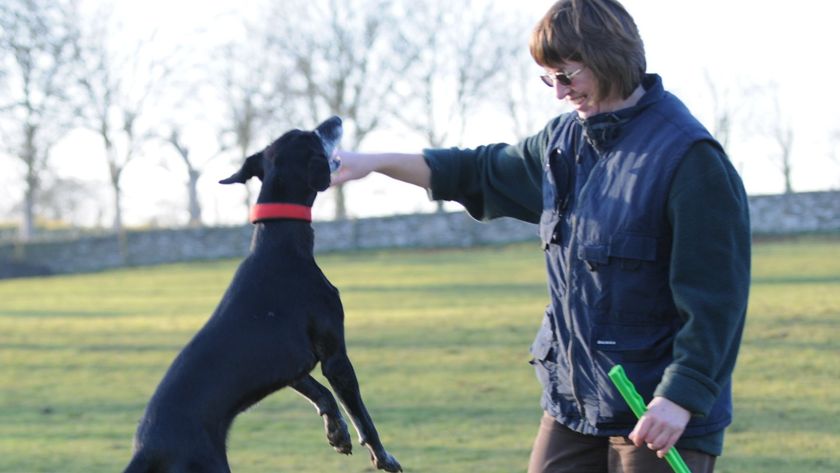Can dogs have panic attacks? Vet's guide to causes and treatment
If your dog is startled by loud noises or strangers, what you may want to know is, can dogs have panic attacks?

Can dogs have panic attacks? This is a common question among owners of anxious or fearful dogs, and the answer is yes. However, not every nervous pup is experiencing a panic attack. If your dog can be distracted by a treat, a game of fetch, or a walk outside, they’re unlikely to be experiencing true panic.
A dog that is having a panic attack is so distressed that it can’t just 'snap out of it'. These dogs may be unable to settle down, even when offered the best calming dog beds or enticing distractions.
Panic attacks can be frightening for owners to witness and they are unpleasant for dogs. While you can’t usually stop a panic attack that’s already in progress, you may be able to prevent future episodes. Read on to learn more about how to handle canine panic attacks.
- Is your dog anxious at night?: A vet's guide to helping them settle down
- Do calming treats for dogs work?
- How to reduce separation anxiety in dogs
Why do dogs have panic attacks?
A panic attack, by definition, is a sudden period of heightened anxiety. In most cases, an attack has an identifiable trigger, which may be a particular sound, event, or location.
Anxiety in dogs is a complex condition, with a number of potential causes. Some dogs seem to have a genetic predisposition to anxiety, which can be triggered by a variety of circumstances. Generalized anxiety can also be triggered by a dog’s experiences early in life or a lack of appropriate socialization.
Many dogs, however, react with anxiety only in specific circumstances. These dogs may be calm much of the time, except when exposed to a specific trigger. Common anxiety triggers in dogs include:
- Separation anxiety, which occurs when the dog is separated from their owner
- Noise phobia, triggered by thunderstorms or fireworks
- Travel-related anxiety, which may occur in vehicles or unfamiliar places
- Social anxiety, which occurs around unfamiliar people or pets
Every dog is different and situations that trigger extreme anxiety in one dog may be tolerated by other dogs – and vice versa. Identifying a dog’s triggers requires careful observation.

Symptoms of a panic attack
Just like humans, a dog experiencing a panic attack may exhibit a variety of symptoms. In the early stages of a panic attack, symptoms are often subtle. You may notice that your dog is panting, pacing, and having a hard time settling down. Your dog may lick its lips or yawn, and you may notice that your dog’s pupils are dilated.
More obvious signs of a panic attack may include whining and trembling. Some dogs are 'clingy' when anxious, seeking their owner’s attention and physical contact. In contrast, other dogs may hide and avoid social interaction completely.
A severe panic attack can cause unpredictable behavior. Your dog may urinate or have a bowel movement indoors, even if they have been successfully house-trained for years.
Your dog may frantically attempt to escape, potentially even injuring itself. Dogs may fracture their teeth chewing on their crate or injure themselves by jumping through a window. Needless to say, panic attacks can also be associated with significant property damage.
How long does a dog panic attack last?
Some dogs have generalized anxiety that affects many of their waking hours. However, in most cases, panic attacks are caused by an identifiable environmental trigger and will end when that trigger is removed.
Panic attacks can last anywhere from minutes to hours. A panic attack caused by a single firework may be resolved within five or ten minutes. In contrast, a panic attack caused by a visitor in your home may last for several hours, or until your guest leaves.

How to stop dog panic attacks
If your dog is having panic attacks, start by talking to your veterinarian, who will be able to prescribe anti-anxiety medication that helps prevent panic attacks:
Medication
Some anxiety medications, such as alprazolam and trazodone, are designed to be given on an as-needed basis, shortly before an anxiety-producing event.
Other medications are given every day, such as clomipramine and fluoxetine. Your veterinarian will determine the best treatment, based on your dog’s anxiety triggers.
Care at home
Until you are able to see your veterinarian, learn how to calm a dog down with home care. In the case of mild anxiety, home care alone may be sufficient.
In dogs with moderate to severe anxiety, home care may at least help take the edge off your dog’s anxiety until you are able to receive appropriate veterinary treatment.
Calming treats
Some owners like to give calming treats for dogs. These calming treats contain a variety of ingredients that are intended to reduce canine anxiety, and they are available over-the-counter.
When purchasing calming treats, however, keep in mind that they are not as well-regulated as prescription medications. Therefore, safety and efficacy may vary. Also, calming treats can react with prescription medications; talk to your veterinarian before giving calming treats if your dog is on any prescription medications.
Create a secluded space
Ensure your dog has a safe environment in which they can hide if they are anxious. Especially in the case of noise phobia, having a secluded space to hide (such as a crate or a dark closet) can make your dog feel more secure. A crate can also be helpful in cases of separation anxiety or social anxiety.
Dogs respond differently to different interventions. What helps one dog may make another dog’s anxiety even worse. Therefore, it may take some trial and error to find the best anxiety management tools for your dogs.
Summary
Can dogs have panic attacks? Absolutely, yes. While all dogs experience brief, occasional episodes of fear or anxiety, panic attacks are characterized by severe anxiety, from which you are unable to distract your dog.
In most cases, managing panic attacks will require veterinary treatment. However, there may also be steps you can take at home to help minimize your dog’s anxiety.
PetsRadar Newsletter
Get the best advice, tips and top tech for your beloved Pets
Dr. Barnette is a graduate of the University of Florida, where she received both her B.S. in Zoology and her Doctor of Veterinary Medicine (DVM). She has 15 years of clinical experience as a small animal veterinarian, treating dogs, cats, and occasional exotic patients. She now works as a freelance veterinary writer, creating educational content for veterinarians, veterinary team members, and dedicated pet owners. Dr. Barnette lives in southwest Florida with her husband and daughter (plus two cats, a dog, and a rescued dove!) and enjoys kayaking, biking, and hiking. Learn more about Dr. Barnette at www.linkedin.com/in/catherinebarnette.












